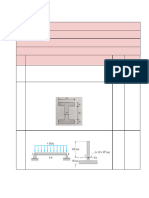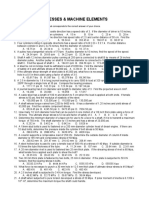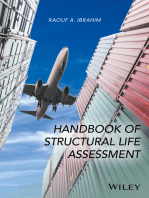HW 1
Uploaded by
azizieh5701HW 1
Uploaded by
azizieh5701Home Work #1 Points: 10 MSE450 due: Mon 1/19/2009 Wed 1/21/2009 -----------------------------------------------------------------------------------------------------------------------------------------1.
A tensile test on 1020 steel gives the following results: Load, kN Diameter, mm Length, mm 0.0 12.8 50.800 No data are taken at maximum load. 22.2 50.848 a. Calculate the elastic modulus. 28.5 (yield begins) b. Calculate the maximum load during the test. [its not 51.2 12.2 56.1 51.2 kN !] 51.2 10.4 67.3 c. Calculate the maximum nominal strain. 43.6 (fracture) 69.8 d. Calculate the strength of the steel. ----------------------------------------------------------------------------------------------------------------------------------------2. The graph shows results of a tensile test of 1040 steel. Specific values at several points are given below: Load,kN Gage Length, cm Diameter, mm Initial 0.0 5.08 12.8 a 23.6 5.0848 12.796 b 27.1 5.19 c 46.4 5.56 12.4 d 52.5 6.25 10.9
i. ii. iv. v. vi. 3.
Calculate the constants K and n for the plastic strain-hardening region. Calculate the modulus of elasticity. iii. Estimate the yield strength. Calculate the maximum stress during the test Estimate the true uniform and necking strains [if the fracture dia is 10mm]. Evaluate the toughness of the material.
A test bar 12.83mm in diameter with a 50mm gage length is loaded elastically with 156kN and is stretched 0.356mm. Its diameter is 12.80mm under load. a. What is the bulk modulus of the bar? b. What is its shear modulus? The stress-strain curve of a material is described by the equation: =6000.35 MPa. a. Find the 0.2% offset yield stress. b. Find the true and nominal stress at the onset of necking. Find the principal stresses 1, 2, 3 as solutions of the determinant. b. Find the hydrostatic part of the stresses. Find the deviatoric part of the stresses (check your answer by calculating the Trace of deviatoric stress).
Given the stress state (MPa) : 20 20 0 20 0 30 40 40 20
4.
5.
a.
c.
6. For the stress state (with respect to x-y axes) : x = 50 ksi, y = 5 ksi, xy = -8 ksi, find the principal stresses.
dS d do not hand in a. In a tensile test, ( de )= 0 at Pmax where necking begins. Show that ( ) = , where and are true stress and d strain respectivley. b. For a material which follows the standard work-hardening law ( = Kn), show that the value of the true strain [u] at the onset of necking is given by the work-hardening parameter, n.
You might also like
- CE 241 Materials Science Solutions of Problem Set 3100% (1)CE 241 Materials Science Solutions of Problem Set 314 pages
- 3 Mec32-1 Simple Stress and Thin Walled CylindersNo ratings yet3 Mec32-1 Simple Stress and Thin Walled Cylinders38 pages
- AWS - CWI Model Question Foundamental - Part 2100% (6)AWS - CWI Model Question Foundamental - Part 217 pages
- Me 3403 Mechanics of Solids Exam 1 Fall 2016No ratings yetMe 3403 Mechanics of Solids Exam 1 Fall 20169 pages
- Dhore - Part-III - Unit I Simple Stresses and Strains Part-III - Engineering Study MaterialsNo ratings yetDhore - Part-III - Unit I Simple Stresses and Strains Part-III - Engineering Study Materials14 pages
- Examination: Testing of Metallic Materials / SS 2011No ratings yetExamination: Testing of Metallic Materials / SS 20116 pages
- Stresses & Machine Elements: Problem Set 1No ratings yetStresses & Machine Elements: Problem Set 118 pages
- Me201 B.tech s3 Mechanics of Solids Sept 2020No ratings yetMe201 B.tech s3 Mechanics of Solids Sept 20203 pages
- B Strength of Materials SP Solution CompressNo ratings yetB Strength of Materials SP Solution Compress4 pages
- Module Title: Mechanical Materials (3D) : MECH8012No ratings yetModule Title: Mechanical Materials (3D) : MECH80124 pages
- Stresses & Machine Elements: PROBLEM SET (Topic 1)No ratings yetStresses & Machine Elements: PROBLEM SET (Topic 1)7 pages
- A circular rod of diameter 20mm and 500mm long is subjected to a tensile force of 45kNNo ratings yetA circular rod of diameter 20mm and 500mm long is subjected to a tensile force of 45kN32 pages
- English Grammar Fast (WWW - Patoghu.com)No ratings yetEnglish Grammar Fast (WWW - Patoghu.com)40 pages
- 1 Duties and Responsibilities Section 1No ratings yet1 Duties and Responsibilities Section 122 pages
- Certified Welding Inspector Program Package: 2009 AWS CWI Seminar and Exam Schedule/Price ListNo ratings yetCertified Welding Inspector Program Package: 2009 AWS CWI Seminar and Exam Schedule/Price List9 pages
- Welding Inspector: Codes & Standards Section 7No ratings yetWelding Inspector: Codes & Standards Section 73 pages
- How A COE (Center of Excellence) Drives Efficiency Across Your Organization - LinkedInNo ratings yetHow A COE (Center of Excellence) Drives Efficiency Across Your Organization - LinkedIn5 pages
- COMMS207 Research Worksheet #2 Jade JugumNo ratings yetCOMMS207 Research Worksheet #2 Jade Jugum2 pages
- CV For Road Safety Specialist - PDF - CompressedNo ratings yetCV For Road Safety Specialist - PDF - Compressed8 pages
- Polisomnografí A Dinamica No Dise.: Club de Revistas Julián David Cáceres O. OtorrinolaringologíaNo ratings yetPolisomnografí A Dinamica No Dise.: Club de Revistas Julián David Cáceres O. Otorrinolaringología25 pages
- Group-Contribution Estimation of Activity Coefficients in Nonideal Liquid Mixtures. Aiche 1975No ratings yetGroup-Contribution Estimation of Activity Coefficients in Nonideal Liquid Mixtures. Aiche 197514 pages
- Tirumala Cotton Recruitment and Selection Recruitment and Selection RCENo ratings yetTirumala Cotton Recruitment and Selection Recruitment and Selection RCE71 pages
- PM Reyes Notes On Taxation 2 - Valued Added Tax (Working Draft)100% (1)PM Reyes Notes On Taxation 2 - Valued Added Tax (Working Draft)22 pages
- Revenue Memorandum Circular No. 24-2018 Subject:: Bureau of Internal RevenueNo ratings yetRevenue Memorandum Circular No. 24-2018 Subject:: Bureau of Internal Revenue6 pages
- Brand Awareness & Preference Regarding Havells Green CFL PDF100% (1)Brand Awareness & Preference Regarding Havells Green CFL PDF74 pages




































































































